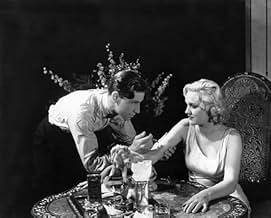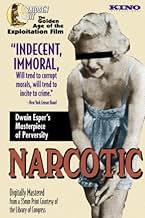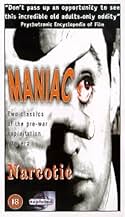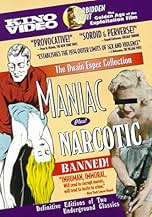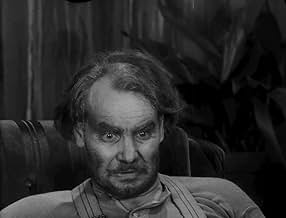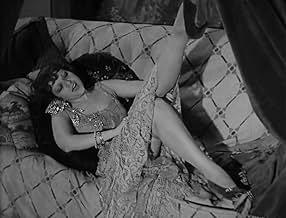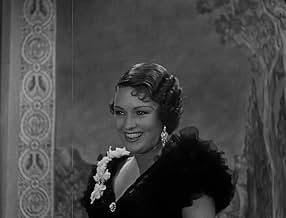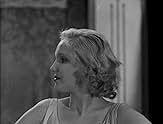Die Abwärtsspirale eines idealistischen Medizinstudenten, dessen Sündenfall ihn in die Opiumhöhlen führtDie Abwärtsspirale eines idealistischen Medizinstudenten, dessen Sündenfall ihn in die Opiumhöhlen führtDie Abwärtsspirale eines idealistischen Medizinstudenten, dessen Sündenfall ihn in die Opiumhöhlen führt
Herman Hack
- Burger
- (Nicht genannt)
Celia McCann
- Prostitute
- (Nicht genannt)
Elmer McCurdy
- Self
- (Nicht genannt)
Fred Parker
- Policeman
- (Nicht genannt)
Philip Sleeman
- Drug Addict
- (Nicht genannt)
Hildegarde Stadie
- Blonde Waiting Outside Davies' Office
- (Nicht genannt)
Blackie Whiteford
- Dennison
- (Nicht genannt)
Empfohlene Bewertungen
Someone who only knows of Esper, coming to this film with n open mind will I think be rather surprised at how good it is. Far from being a mindless hack who churned out any oddly rubbish for the so-called "exploitation" market, Esper very clearly had aspirations of an artistic kind and experiments with European-style montage (not simply "irrelevant footage" as one reviewer seems to think), very rare in US film, and with some interesting chiaroscuro effects. This sometimes makes the continuity a little dodgy but gives the film a certain quality much superior to the general run of "Poverty Row" films.
By contrast, his follow-up, Maniac, which dabbles in horror/melodrama somewhat in the line of the contemporary British star Tod Slaughter, is not nearly so good a film and gives a yardstick by which to appreciate the real qualities of Narcotic.
What one also sees most clearly with Esper at his best is the way in which the "exploitation" film is really a sort of alter ego, a shameful double of the US industry as a whole. Consider for instance how a typical police-operation gangster film uses essentially the same tropes - one part of the film follows the police or the FBI (emphasising the evil of the gangsterism in narrations that are not unlike Esper's supposedly didactic intertitles, while the other part of the film allows the viewer to enjoy the antics of the gangster.
Genre after genre in US cinema in fact exhibit the same essential traits as the "exploitation" film because it is what, between censorship rules and greed for high profits, the US film industry had essentially learned to be and Esper's films are simply a microcosm, Hollywood denuded of its glamour.
Note two how this film is interestingly rooted in the memory of Hollywood with silent stars Paul Panzer and Josef Swickard and even the son of film pioneer Stuart Blackton amongst the cast.
By contrast, his follow-up, Maniac, which dabbles in horror/melodrama somewhat in the line of the contemporary British star Tod Slaughter, is not nearly so good a film and gives a yardstick by which to appreciate the real qualities of Narcotic.
What one also sees most clearly with Esper at his best is the way in which the "exploitation" film is really a sort of alter ego, a shameful double of the US industry as a whole. Consider for instance how a typical police-operation gangster film uses essentially the same tropes - one part of the film follows the police or the FBI (emphasising the evil of the gangsterism in narrations that are not unlike Esper's supposedly didactic intertitles, while the other part of the film allows the viewer to enjoy the antics of the gangster.
Genre after genre in US cinema in fact exhibit the same essential traits as the "exploitation" film because it is what, between censorship rules and greed for high profits, the US film industry had essentially learned to be and Esper's films are simply a microcosm, Hollywood denuded of its glamour.
Note two how this film is interestingly rooted in the memory of Hollywood with silent stars Paul Panzer and Josef Swickard and even the son of film pioneer Stuart Blackton amongst the cast.
Watching Narcotic as a film for its own sake--as an artwork or a piece of entertainment, that is--at this point in time is not entirely satisfactory. For one, it's very choppy. Scenes are missing or truncated oddly, but this is the best print known at the moment. But even if the missing footage were replaced, the film is still uneven. Director Dwain Esper and his wife, writer Hildegarde Stadie, have a bizarre sense of dramatic construction only rivaled by Ed Wood. Esper inserts odd shots for symbolism (such as poisonous snakes, skunks and such near the end), inserts odd intertitles at odd times, and so on. And a lot of the performances intermittently go off the rails. Yet as a historical and sociological oddity, Narcotic is fascinating. Any film buff worth his or her weight in Fassbinder posters should be familiar with it, as should anyone interested in sociology or cultural theory.
I'm not sure if this is the first paranoid anti-drug film, but it must be one of the earlier ones. It beat Esper's similar and more famous Reefer Madness by three years. Additionally, this is much broader in scope than that later film. It's not quite as black and white or ridiculously propagandistic, and it's supposedly based on a true story--a real equivalent to Dr. William G. Davis (played here by Harry Cording), who went on the road hawking "Tiger Fat" (a name only mentioned in intertitles here as far as I could tell), and who was a drug addict stuck in a depressing downward spiral.
The content, which focuses on explicit drug use (including scenes of drug preparation), violence--both accidental and intentional--that remains morally unrectified, serious relationship problems, drug-induced and illicit sexual behavior, and a fantastic, nihilistic ending, may sound like a perfect recipe for a Cheech and Chong film, but in 1933, it was all very challenging. So challenging that the film was rejected twice (once on appeal) by the New York State Film Board. Documentation about this is an interesting special feature on the Kino DVD.
I certainly do not agree with censorship, but the New York State Film Board was astute in some of its criticism of the film. Although viewers could hardly desire ending up like Dr. Davis in the end, many of the scenes are not clearly anti-drug and debauchery. Many scenes seem pro drug and debauchery instead, especially to someone with a hedonistic, libertarian bent, such as myself. They also show basic preparation and administration techniques for drugs.
Although it doesn't seem consistent with their filmographies, Esper and Stadie seem to show pretty explicitly that they're not clearly anti-drug in the comments from "Chinese" character Gee Wu (J. Stuart Blackton, Jr.). Wu presents a pro-opium view early in the film, and through the character, Esper and Stadie suggest that the problem with drugs lies more with cultural differences than in the drugs themselves, even though they seem to backpeddle a bit further into the film.
It's beneficial to keep these kinds of things in mind while watching Narcotic--they'll keep you interested and help stave off Morpheus.
I'm not sure if this is the first paranoid anti-drug film, but it must be one of the earlier ones. It beat Esper's similar and more famous Reefer Madness by three years. Additionally, this is much broader in scope than that later film. It's not quite as black and white or ridiculously propagandistic, and it's supposedly based on a true story--a real equivalent to Dr. William G. Davis (played here by Harry Cording), who went on the road hawking "Tiger Fat" (a name only mentioned in intertitles here as far as I could tell), and who was a drug addict stuck in a depressing downward spiral.
The content, which focuses on explicit drug use (including scenes of drug preparation), violence--both accidental and intentional--that remains morally unrectified, serious relationship problems, drug-induced and illicit sexual behavior, and a fantastic, nihilistic ending, may sound like a perfect recipe for a Cheech and Chong film, but in 1933, it was all very challenging. So challenging that the film was rejected twice (once on appeal) by the New York State Film Board. Documentation about this is an interesting special feature on the Kino DVD.
I certainly do not agree with censorship, but the New York State Film Board was astute in some of its criticism of the film. Although viewers could hardly desire ending up like Dr. Davis in the end, many of the scenes are not clearly anti-drug and debauchery. Many scenes seem pro drug and debauchery instead, especially to someone with a hedonistic, libertarian bent, such as myself. They also show basic preparation and administration techniques for drugs.
Although it doesn't seem consistent with their filmographies, Esper and Stadie seem to show pretty explicitly that they're not clearly anti-drug in the comments from "Chinese" character Gee Wu (J. Stuart Blackton, Jr.). Wu presents a pro-opium view early in the film, and through the character, Esper and Stadie suggest that the problem with drugs lies more with cultural differences than in the drugs themselves, even though they seem to backpeddle a bit further into the film.
It's beneficial to keep these kinds of things in mind while watching Narcotic--they'll keep you interested and help stave off Morpheus.
Of the various low-budget exploitationers of the 1930s, I was only familiar with the similarly drug-related TELL YOUR CHILDREN (1938), better-known by its alternate title REEFER MADNESS – actually produced by Dwain Esper, the co-director of this one and a film-maker whose notorious reputation (for lack of talent) rivals that of Ed Wood himself! Here, then, we ostensibly have the case history (cue exhaustive exposition in the form of title cards) of a doctor who indulged in various types of drugs, starting out with opium (suggested by the stereotypical wise-yet-evil Chinese) but soon progressing to heroin
all of which ends with him losing everything (living in a two-bit dive and eventually turning a gun on himself!). While I was expecting horrific hallucinations or (unintentionally hilarious) hyperbolic reactions resulting from the intake of drugs, all one got is an excess of dull talk which quickly exasperated this viewer long before the film's brief 57 minutes were up! Still, there were at least three scenes which have to be seen to be believed: a chauffeur popping pills while driving gets his car smashed by an oncoming train; the lengthy "drug party" itself with the participants freely sniffing coke and injecting heroin while dancing and bickering amongst themselves; and a completely irrelevant bit (obviously stock footage) of a couple of snakes fighting capped by the victor literally swallowing up the defeated reptile!
Although this movie is supposedly based on actual events, the production values of the film betray that it is yet another old exploitation film--the sort that were produced by fly-by-night production companies to prey upon the public's fear AND fascination with sex and drugs. But, since such topics could not generally get past the censor boards of each state, they were marketed as "educational" and shown to adults-only audiences. Some of the obvious problems with the film are the use of silent film footage (when shown on a normal projector, it runs too fast and looks odd), clips of a baby being delivered by c-section (for little apparent reason other than they happened to have the film and decided to shove it into the movie) as well as choppy editing and poor acting. It's obvious th was NOT a large budget production, but made 'on the cheap', so to speak.
After showing a lot of seemingly irrelevant stock footage, the story begins. A Chinese man who looks about as Chinese as Eddie Murphy is talking with a couple American men. Later, one of them approaches this 'Asian' and requests that they do some opium together. So, they go to an opium den and hit the pipe. While this is pretty cheesy since the Chinese guy obviously ISN'T, the way they demonstrate opium and the paraphernalia is surprisingly accurate compared to the information you usually get in such films. Soon you see the two drift into a blissful stupor. Later, the American guy goes back for more and he's obviously hooked. How this turns him into a man who sells patent medicines is beyond me.
The rest of the film is jam-packed full irrelevant film footage--including odd clips of sideshow freaks, speeding cars and, cats staring at snakes--once again, whatever they seemed to have on hand--slapping it all together and hoping to make a semi-coherent film. And, unlike the segment on opium, the drug information is, to put it charitably, histrionic! Supposedly wild parties and a guy ripping the dress off his wife when he ran out of drugs are among the more outlandish scenes in this film--that, by this point, has become an almost plot less mess. By then end, the opium addict is a complete and total mess and he begins quoting Bible verses about the danger of alcohol--as he calls out to God and then kills himself. Believe it or not, this scene actually is well done--with some dandy acting by the addict. But, sadly, it's about the only well made portion of the film! Some of the problems with the film were probably not originally in the film. Many times, the film appears to have little bits and pieces missing and as a result, the film is pretty choppy. Considering this was a Kino DVD, I assume this is simply the best copy they have as this company usually does a good job in producing excellent quality disks.
It's obvious from my review that this is a terrible film. But, is it worth seeing--after all, some bad films are so stupid and clumsily made that they are fun to see and laugh at--especially with friends. Well, this film is stupid and you will laugh a bit at its horribleness--but it never quite reaches the same level of histrionics and stupidity of such cult classic bad films as "Reefer Madness". Still, it's good for a laugh or two and probably did little to educate anyone--especially with such lines as "Ladies, ladies...let's not get vulgar...YET!".
After showing a lot of seemingly irrelevant stock footage, the story begins. A Chinese man who looks about as Chinese as Eddie Murphy is talking with a couple American men. Later, one of them approaches this 'Asian' and requests that they do some opium together. So, they go to an opium den and hit the pipe. While this is pretty cheesy since the Chinese guy obviously ISN'T, the way they demonstrate opium and the paraphernalia is surprisingly accurate compared to the information you usually get in such films. Soon you see the two drift into a blissful stupor. Later, the American guy goes back for more and he's obviously hooked. How this turns him into a man who sells patent medicines is beyond me.
The rest of the film is jam-packed full irrelevant film footage--including odd clips of sideshow freaks, speeding cars and, cats staring at snakes--once again, whatever they seemed to have on hand--slapping it all together and hoping to make a semi-coherent film. And, unlike the segment on opium, the drug information is, to put it charitably, histrionic! Supposedly wild parties and a guy ripping the dress off his wife when he ran out of drugs are among the more outlandish scenes in this film--that, by this point, has become an almost plot less mess. By then end, the opium addict is a complete and total mess and he begins quoting Bible verses about the danger of alcohol--as he calls out to God and then kills himself. Believe it or not, this scene actually is well done--with some dandy acting by the addict. But, sadly, it's about the only well made portion of the film! Some of the problems with the film were probably not originally in the film. Many times, the film appears to have little bits and pieces missing and as a result, the film is pretty choppy. Considering this was a Kino DVD, I assume this is simply the best copy they have as this company usually does a good job in producing excellent quality disks.
It's obvious from my review that this is a terrible film. But, is it worth seeing--after all, some bad films are so stupid and clumsily made that they are fun to see and laugh at--especially with friends. Well, this film is stupid and you will laugh a bit at its horribleness--but it never quite reaches the same level of histrionics and stupidity of such cult classic bad films as "Reefer Madness". Still, it's good for a laugh or two and probably did little to educate anyone--especially with such lines as "Ladies, ladies...let's not get vulgar...YET!".
While not as over-the-top as Dwain Esper's MANIAC or as professionally made as his MARIJUANA: WEED WITH ROOTS IN HELL, NARCOTIC is a unique film experience. It has a jumpy, elliptical style--sometimes the next scene may be a few days after the prior scene, sometimes a few months or even years. Add to this the use of stock footage from silent films (in the first half) and stock footage of animals killing each other (in the last third).Also, the script mixes philosophy with medical jargon with drug slang with hard-boiled dialogue. And Esper's preference for odd, off-putting camera angles and introducing characters by showing their shadow.The whole thing, in under one hour, has a grimy feel to it. Even the worst poverty row b-movie tries, on some level, to be entertaining, no matter how far it misses that mark. This film really is NOT trying to entertain--it tries to create certain moods and reactions in the viewer, and it will use non-rational, expressionistic techniques to create those effects in the viewer. It's MUCH different from other 30s exploitation films such as REEFER MADNESS and COCAINE FIENDS. One must give Esper credit--the film was made 70 years ago but it is still a disquieting experience.
Wusstest du schon
- WissenswertesThe film includes an appearance of Elmer McCurdy, an Oklahoma would-be bank robber who was killed in 1911, and whose embalmed body circulated through various sideshows, fun houses and amusement parks for over 60 years. McCurdy's body was not only used as that of a "drug addict" in the film but was put on display by Dwain Esper at screenings of the movie. McCurdy was eventually discovered in a Long Beach (CA) funhouse in 1977 by a film crew for the TV series Der Sechs-Millionen-Dollar-Mann (1974) and he was returned to Oklahoma for proper burial.
- PatzerWhen Davies is persuading his wife that his plan will work, the boom shadow falls the wall behind them. Also, the mike dips briefly into the shot and, and the camera moves forward, the shadow of the accordion-style apparatus used to hoist the mike is also visible, almost distractingly so, on the wall, right behind the wife.
- VerbindungenFeatured in Narcotic Dens of the Orient (1953)
Top-Auswahl
Melde dich zum Bewerten an und greife auf die Watchlist für personalisierte Empfehlungen zu.
Details
Box Office
- Budget
- 8.900 $ (geschätzt)
- Laufzeit57 Minuten
- Farbe
- Sound-Mix
- Seitenverhältnis
- 1.37 : 1
Zu dieser Seite beitragen
Bearbeitung vorschlagen oder fehlenden Inhalt hinzufügen

